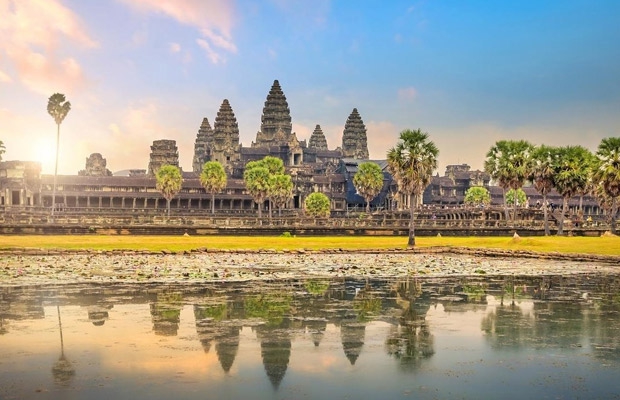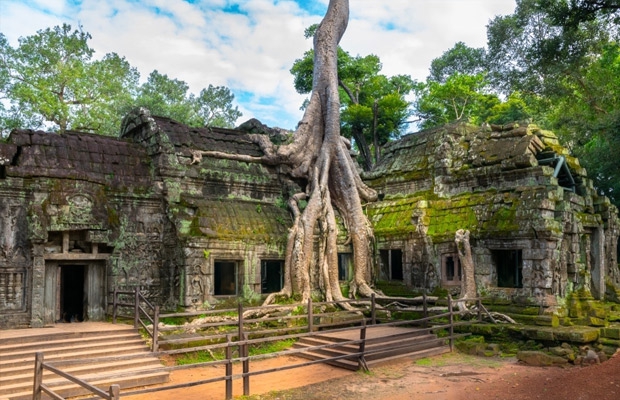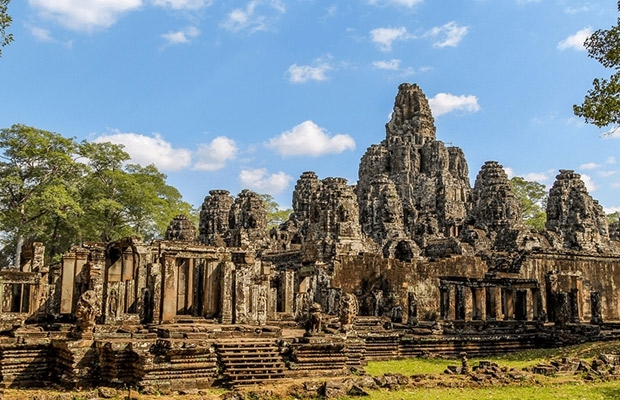Angkor Wat Temple
Angkor Wat Temple
Angkor Wat (Capital of Temples) is a temple complex in Cambodia and the largest religious monument in the world by land area, on a site measuring 162.6 hectares (1.626 km2; 402 acres). Originally constructed as a Hindu temple[1] dedicated to the god Vishnu for the Khmer Empire, it was gradually transformed into a Buddhist temple towards the end of the 12th century, and as such it is also described as a "Hindu-Buddhist" temple. It was built by the Khmer King Suryavarman II[5] in the early 12th century in Yaśodharapura ( present-day Angkor), the capital of the Khmer Empire, as his state temple and eventual mausoleum. Breaking from the Shaiva tradition of previous kings, Angkor Wat was instead dedicated to Vishnu. As the best-preserved temple at the site, it is the only one to have remained a significant religious centre since its foundation. The temple is at the top of the high classical style of Khmer architecture. It has become a symbol of Cambodia, appearing on its national flag, and it is the country's prime attraction for visitors.
Angkor Wat combines two basic plans of Khmer temple architecture: the temple-mountain and the later galleried temple. It is designed to represent Mount Meru, home of the devas in Hindu mythology: within a moat more than 5 kilometres (3 mi) long[8] and an outer wall 3.6 kilometres (2.2 mi) long are three rectangular galleries, each raised above the next. At the centre of the temple stands a quincunx of towers. Unlike most Angkorian temples, Angkor Wat is oriented to the west; scholars are divided as to the significance of this. The temple is admired for the grandeur and harmony of the architecture, its extensive bas-reliefs, and for the numerous devatas adorning its walls.
- Siem Reap
Overview
Angkor Wat (Capital of Temples) is a temple complex in Cambodia and the largest religious monument in the world by land area, on a site measuring 162.6 hectares (1.626 km2; 402 acres). Originally constructed as a Hindu temple[1] dedicated to the god Vishnu for the Khmer Empire, it was gradually transformed into a Buddhist temple towards the end of the 12th century, and as such it is also described as a "Hindu-Buddhist" temple.
Siem Reap Tours
- Visit Country Organic Farm by Bike
- Street Food Tour
- Cooking Class
- Angkor Complex with Circus
- Monk Blessing Tour
- Siem Reap Multi Activities
- Phnom Kulen and Beng Mealea Tour
- Siem Reap Community Homestay Tour
- Sambor Prei Kuk Tour
- Siem Reap Cycling, Trekking and Kayaking
- Sunset Safari by Quad Bike
- Phnom Kulen Tours
 English
English Khmer
Khmer Chinese
Chinese Korean
Korean Japanese
Japanese French
French Spanish
Spanish Thai
Thai German
German Russian
Russian Vietnamese
Vietnamese Italian
Italian



